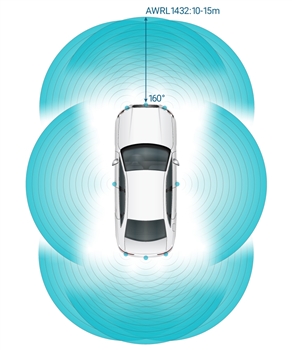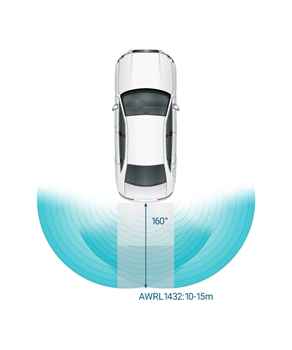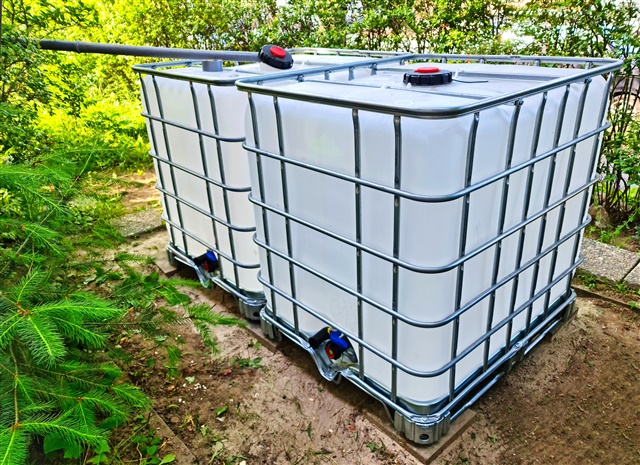SSZTCY7 August 2023 AWRL1432 , IWRL1432
Over the past decade, radar-based sensors became an established sensing modality for automotive and industrial applications. Radar helps realize designs that require long range, environment resiliency and higher sensing resolution, making them a good fit for advanced driver assistance systems (ADAS) such as collision detection, as well as level sensing.
With the introduction of complementary metal-oxide semiconductor (CMOS)-based system-on-a-chip (SoC) radar sensors, radar has become easier to develop and deploy in applications such as automotive park assistance, kick-to-open (KTO) sensing, door obstacle detection, robotics and e-bikes.
In order to meet the requirements of cost- and power-limited automotive and industrial applications, today’s 77-GHz radar SoC sensors require architectures designed from the ground up. Devices such as TI’s AWRL1432 and IWRL1432 SoCs have power-management features to quickly duty cycle into different power states, effectively running internal components such as radar front end, digital processing cores or memory, only when needed. Reducing the average power consumption from the typical >1 W to <5 mW (depending on chirp configuration) gives hardware designers more flexibility in their thermal designs, and can also reduce cost through the removal of heat sinks and simplified printed circuit board designs.
Enabling new and more flexible installations with software-defined radar
An automaker’s decision to choose a sensing modality has often depended on a sensor’s purpose in the vehicle; for example, kick-to-open (KTO) sensors should be in standby detection mode when the vehicle is parked and locked. To prevent draining the vehicle battery while in park, automakers traditionally selected low-power sensing modalities such as capacitive or ultrasonic. Unfortunately, however, these sensors have challenges with false detection, environmental reliability, and recognition performance. Low-power 77-GHz radars such as the AWRL1432 have a standby presence detection power consumption <3 mW, improve recognition accuracy regardless of environmental conditions, and facilitate simpler installations that reduce total system deployment costs.
It is possible to configure a radar sensor to dynamically switch into different operating modes, depending on the need for low power or high performance. Using KTO sensing as an example, a device can operate in <3-mW standby presence detection mode, then upon the detection of a person switch into a high-performance mode for kick gesture recognition and false detection capability, as shown in Figure 1.
 Figure 1 One AWRL1432 radar sensor can
dynamically switch between low-power and high-performance modes
Figure 1 One AWRL1432 radar sensor can
dynamically switch between low-power and high-performance modesIn the ADAS space, legacy park-assistance systems use 8 to 12 ultrasonic sensors, along with camera sensors, but are now evolving to become a more robust and cost-efficient automated system. While it is possible for each ultrasonic sensor to be cost-efficient, major drawbacks include the sensor’s impact on the aesthetics of the car (because of the holes necessary), performance in harsh environments, and range detection performance (the minimum and maximum measurable distance).
Instead of adding more ultrasonic sensors, automotive designers can now leverage existing corner radar sensors with a park-assistance function, along with TI’s cost-efficient AWRL1432 integrated radar SoC for field-of-view coverage around the car, as shown in Figure 2. AWRL1432 ultra-short-range radar sensors can detect static objects as close as 3 cm and as far away as 15 m, depending on the antenna configuration.
 Figure 2 360-degree coverage for park
assistance using radar sensors
Figure 2 360-degree coverage for park
assistance using radar sensorsAs shown in Figure 3, you can use the same sensor in the center of the vehicle bumper for both park assistance and KTO, and use the corner sensors for both park assistance and blind-spot detection. In order to enable this multimodal usage, the radar sensors must not only be software-configurable, but also must have the architectural flexibility to scale from high performance to low power on demand.
 Figure 3 A multimodal radar sensor
handling both park assistance and KTO
Figure 3 A multimodal radar sensor
handling both park assistance and KTOOperating in harsh industrial environments with low-power radar sensors
Ultrasonic sensors have been popular for the proximity sensing of objects and humans in nonautomotive applications such as vehicle access control in parking barriers or collision avoidance in off-highway vehicles such as construction forklifts, agricultural machines and e-bikes as shown in Figure 4. Because of higher accuracy requirements, 77-GHz radar sensors are replacing ultrasonic sensors. Given its lower cost, the IWRL1432 can help make parking barrier sensors more affordable to implement and deploy in a much smaller form factor. The higher radio-frequency performance in these sensors also make them suitable for object detection and deployment on e-bikes, scooters and agricultural equipment that needs to detect objects and humans at distances from 1 m to more than 60 m.

 Figure 4 Applications in harsh environments where 77GHz radar solves sensing challenges
Figure 4 Applications in harsh environments where 77GHz radar solves sensing challengesTank-level sensors, as pictured in Figure 5, measure the level of liquids and solids in industrial environments – even in the midst of vapors, foam and other challenging conditions – by emitting radio waves that are reflected by a liquid or solid surface (such as chemicals, oils or liquids). The primary requirements in this application are very low power consumption, detection accuracy and worker safety. 77-GHz IWRL1432 sensors, with their built-in deep-sleep modes, enable power consumption of <10 mJ/measurement, are Safety Integrity Level 2-targeted, and provide millimeter-level measurement accuracy.
 Figure 5 77GHz radar sensor installed at the top of the Industrial tank for level measurement
Figure 5 77GHz radar sensor installed at the top of the Industrial tank for level measurementConclusion
Ultrasonic and capacitive sensing in automotive or industrial applications have their own design challenges. Cost- and power-optimized devices in the radar sensing space can not only help solve these design challenges, but also open the door for emerging applications around the vehicle or in an industrial environment.